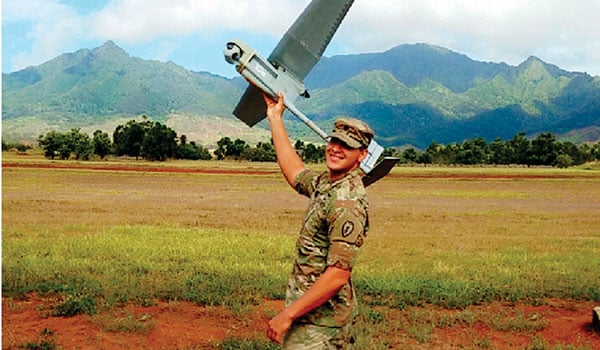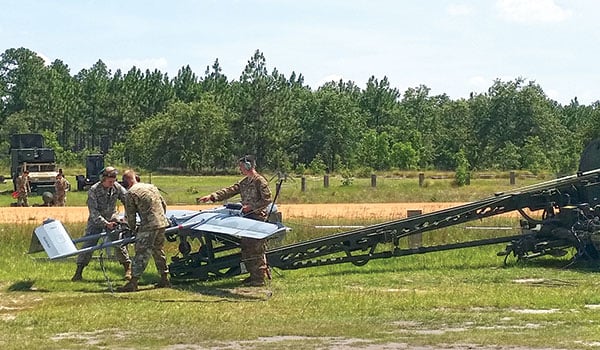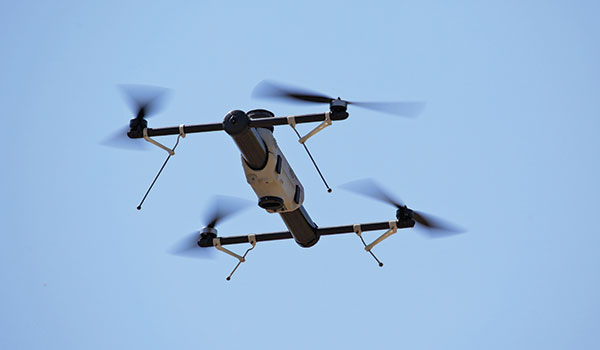
By CW2 Eric Roberts: Army aviation has a historical pattern of undergoing major changes, but the recent proliferation of unmanned aircraft systems (UAS) is a cogent variation from the typical airframe upgrades, modifications or unit restructuring to which we have become accustomed. While larger UAS systems like Shadow and Gray Eagle function under Army Aviation branch, one of the most abundant groups of UAS known as small UAS or (SUAS) are most often placed in the hands of the barely trained junior Infantry Soldiers. There is no denying that SUAS provides vital capabilities for Infantry commanders, yet, is the asset being managed and employed in the safe and effective manner that aviation systems require?

U.S. Army SPC Oscar Rios of 3rd Infantry Brigade Combat Team, 25th Infantry Division, poses with a RQ-11B gimbaled Raven during a training session at Schofield Barracks, HI, June 30, 2016. / U.S. ARMY PHOTO
Background
In an Army sponsored research study, investigators from the University of South Dakota Human Factors Psychology Department surveyed the UAS and SUAS Soldiers of an Infantry combat brigade outfitted with Shadow and Raven systems to compare the management of the respective programs and their specific training methods. Survey instruments were distributed to UAS and SUAS operators and their supervisors based on the specific roles they performed in unmanned missions. The survey was voluntary and asked participants to respond to questions about topics such as regulatory requirements, currency, and their post qualification continuation training.
SUAS operators, such as Raven operators are typically Infantry branch enlisted soldiers E-1 through E-5 who attend the two week qualification course. On average they attain two to three hours of flight time on the systems by the time of course graduation. Though the qualification course syllabus calls for students to acquire 5 hours of flight time, constraints such as limited range hours, high student to instructor ratio, and weather considerations often cut their training in half.
Research Questions
The objective of the study was to gain statistical based insight, which would answer specific research questions regarding SUAS management and employment in the Army. Those questions included:
Are Army SUAS operators receiving the necessary post-qualification continual training to safely employ the system? Training standards are established in AR 95-2, but are the operators are fulfilling those requirements? Is training documented and suitable for promoting unit readiness?

U.S. Army Shadow maintainers and operators assigned to the 82nd Airborne Division, conduct engine start procedures on the RQ-7Bv2 at Fort Bragg, NC, June 26, 2016. / U.S. ARMY PHOTO
If Army SUAS operators are not getting the appropriate continual training, should SUAS be a separate Military Occupational Specialty (MOS) that is branched in Aviation, rather than as an additional duty that is managed by the Infantry? Being that SUAS is an aviation system, is it practical for SUAS to be utilized outside of Aviation branch? The operators are flying the aircraft in airspace that is shared by manned aircraft which poses a new unpredictable threat to Army Aviators.
At the very least, should SUAS operator be a separate MOS embedded in the Infantry, where the primary duty is training on and employing the system(s)? There may be excessive challenges present that would be prohibitive to successful re-branching of SUAS operators at this time. If this is the case, would it be beneficial to designate a new MOS for SUAS operators to ensure proper career training and emphasis on safe system employment?
Results
When participants were asked if they thought that SUAS operation should be branched as an MOS in Army Aviation, instead of an additional duty in the Infantry, 86.36% of operators and 92.86% of supervisors agreed with the proposed change. This wasn’t surprising as 47.06% Raven operators state their primary MOS interferes with their ability to perform SUAS duties and 84.61% of the Raven operators had not flown the system for greater than 180 days. Since flying is a relatively technical natured activity it is impractical for operators to have proficiency with a system when they rarely get to use it. While the percentage of non-current SUAS operators was significant, more alarming was the fact that 76.9% of those operators believed that they were current, or were completely unaware that any currency requirements were prescribed in AR 95-2.
If re-branching SUAS isn’t an option, 86.36% of operators and 78.57% of supervisors supported the idea that SUAS operator should still be a separate MOS, rather than an additional duty. Those views are well supported when considering operator and supervisor confidence in system employment. We asked the operators to rate how confident they would be to employ the system today without incident. The reported averages were 62.3% for Raven Operators and 84% for Shadow Operators. Upon asking their supervisors the same question they answered with a score of 51% for Raven operators versus 92.5% for Shadow operators.

AeroVironment, Inc’s Shrike currently is used for police forces and is one of many SUAS being developed for military applications. / AEROVIRONMENT PHOTO
Loss of UAS equipment due to negligence based incidents is a concern as replacement parts and devices can get expensive. However, more importantly is the potential for injury or loss of life due to a collision or influence over manned aircraft traffic. When questioning the confidence level of integrating into multi-user airspace Raven operators gave a mean rating of 55.9% whereas Shadow operators responded with 88%. Their supervisors paralleled the operator views scoring 43% for Raven operators versus 95% for Shadow operators. Supporting those scores is the fact that 40% of the surveyed Raven supervisors had witnessed an operator violating airspace and flying outside of the prescribed Restricted Operating Zone (ROZ).
Discussion
Continuation training plays a pivotal role in pilot proficiency. Lack of confidence by SUAS operators to employ the system stems from the absence of currency flight training. Over similar career spans, the average number of total completed sorties was self-reported to be 9.57 for Raven operators. In contrast, the average number of sorties was 66.8 for Shadow operators. Operator retention in the unit is a present issue as well. According to Raven supervisors, 60% of the time an operator is retained in the unit less than 1 year after attending the qualification course.
Due to their overall relative low cost, unmanned systems are rapidly outnumbering manned aircraft. Recent advances in multi-rotor systems are highly likely to bring an abundance of new capabilities to the warfighter. As the military adopts an increased use of SUAS, the civilian sector is also following suit. Companies like Amazon are eager to get their systems off the ground and start operating in the National Airspace. It is critical for the military to take lead on fostering safe and proficient SUAS operators to prevent a future manned unmanned incident.
Unmanned aircraft sightings and near misses with manned aircraft have risen sharply. Unfortunately this data has not been adequately tracked for military airspace users, so an accurate estimation is not yet possible. The question of a collision is shifting from an “if it occurs” situation to a “when it happens” scenario. Airspace authorities have been adapting to UAS growth, but proper operator training programs that stress proficiency and situational awareness will always be the tipping point.
CW2 Eric Roberts is the aviation mission survivability officer at Company C, 2nd Bn., 285th Avn. Regt. in Bismarck, ND. He is qualified as an OH-58D Kiowa Warrior pilot and UH-60A/L Black Hawk pilot and has experience with various unmanned systems. He is currently pursuing a Ph.D. in Human Factors focusing on aviation applications.











